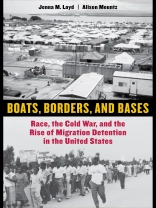Discussions about U.S. migration policing have traditionally focused on enforcement along the highly charged U.S.-Mexico boundary. Enforcement practices such as detention policies designed to restrict access to asylum also transpire in the Caribbean.
Boats, Borders, and Bases tells a missing, racialized history of the U.S. migration detention system that was developed and expanded to deter Haitian and Cuban migrants. Jenna M. Loyd and Alison Mountz argue that the U.S. response to Cold War Caribbean migrations established the legal and institutional basis for contemporary migration detention and border-deterrent practices in the United States. This book will make a significant contribution to a fuller understanding of the history and geography of the United States’s migration detention system.
Mục lục
Illustrations
Acknowledgments
Abbreviations
Introduction
PART ONE. RACE AND THE COLD WAR GEOPOLITICS
OF MIGRATION CONTROL
1. “America’s ‘Boat People’”
Cold War Geopolitics of Refuge
2. Militarizing Migration
The Politics of Asylum and Deterrence
PART TWO. BUILDING THE WORLD’S LARGEST DETENTION SYSTEM
3. “Not a Prison”
Building a Deportation Hub in Oakdale, Louisiana
4. “Uncle Sam Has a Long Arm”
War and the Making of Deterrent Landscapes
PART THREE. EXPANDING THE WORLD’S LARGEST
DETENTION SYSTEM
5. Safe Haven
The Creation of an Off shore Detention Archipelago
6. Onshore Expansion
Consolidating Deterrence through Criminalization
and Expulsion
7. Post-9/11 Policing
Back to the Future
Coda
Notes
References
Index
Giới thiệu về tác giả
Jenna M. Loyd is Assistant Professor of Geography at the University of Wisconsin-Madison.Alison Mountz is Professor of Geography at Wilfrid Laurier University and Canada Research Chair in Global Migration at the Balsillie School of International Affairs .











